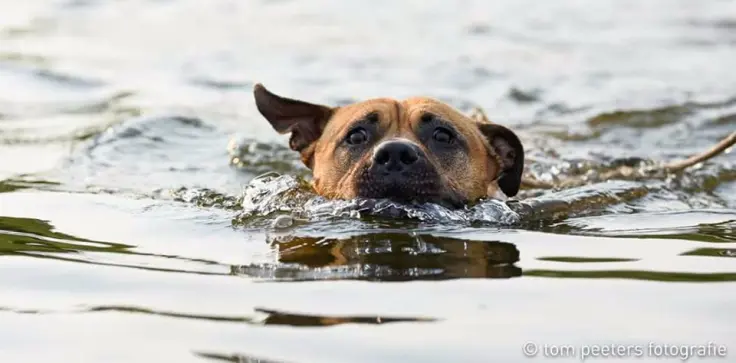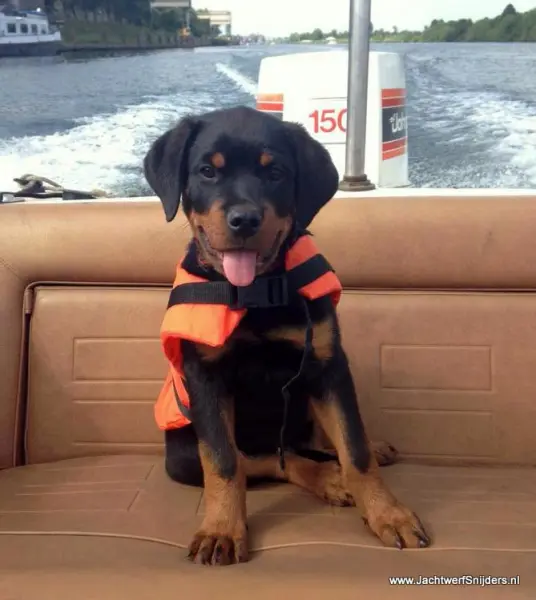The first beautiful, warm summer day! You wake to birdsong, leap out of bed in a great mood. You’ve already mapped out the whole day in your head: today you’re going swimming with your dog for the very first time! You can picture it perfectly—your dog swimming after a ball, the two of you crossing the pond in perfect harmony, splashing and having fun, just like in ads and movies.
Full of confidence and a little light-headed, you and your dog arrive at the water. Expectantly, you look at your dog with your phone at the ready to capture an awesome reel of his first swimming adventures; you hit “record,” swing the camera from the water toward your dog and see… that your dog is backing up with a low, tense posture. He glances nervously at the water and puts pressure on the leash. He clearly wants to get out of there.
There go your dreams, your visualizations, your Facebook likes, and your Lassie or Inspector Rex adventures. Your dog is afraid of water….

You quickly switch gears—this can’t be happening. On to plan B. You grab a handful of treats and hold them in front of your dog’s nose, then toss one into the water. Unfortunately, your usually food-driven four-legged friend shows no interest in food whatsoever. So you try to take it a bit slower: you place some kibble at his feet and make a trail toward the water. But alas, your dog doesn’t seem impressed by that either. He doesn’t even look at it!
Luckily, you brought his favorite toy. You wave it enthusiastically in front of his nose with all kinds of silly gestures and noises, then throw it with a graceful arc into the water. You look at your dog expectantly… Nothing. No sound, no movement. At most he looks up at you a bit sheepishly, with no intention of moving toward the water.
Meanwhile, the favorite toy is slowly drifting away, so slightly irritated, you hand your dog’s leash to your mother, partner, friend, or a passerby so you can go after the rather expensive toy before it disappears from sight or another dog runs off with it.
Back at your dog, the disappointment begins to set in: you were going to have an awesome day together, you were going to have a great time—you didn’t walk all the way here just to make a fool of yourself and head home without even touching the water, right? It’s hot, swimming is fun—why doesn’t your dog get that? What’s wrong with your dog?
You grip the leash firmly and head for the water yourself, dragging your dog behind you. Once you’re in the water, he’ll realize it isn’t scary and follow you, you think. The closer you get to the water, the more your dog digs in his heels, and your relaxed day has turned into a full-on workout.
Now you’re standing knee-deep in the water, looking into your dog’s wide, panicked eyes as he desperately tries to avoid that strange liquid around his paws. Just a little farther, you think—if I pull him into the water now, he’ll notice nothing bad happens and then we can finally enjoy ourselves together. You brace yourself and pull.
Fortunately, you put a well-fitting harness on your dog, because he’s desperately trying to get away from your pressure. If he were to slip free now, you know he’d definitely run off.
You pull and pull, and your dog’s paws come into contact with the water one by one. But the resistance doesn’t seem to lessen. You keep tugging on the leash just as often and just as hard until your dog is next to you and you wrap him in your arms—that will surely calm him down! Nothing could be further from the truth: your dog thrashes about in blind panic in your arms, and there’s clearly only one thought in his head: “Away! I have to get out of here!” You try to hold him back, but he splashes a wave of water into your face and you feel his nails claw sharply at your skin. In the end you have to let go, and your dog bolts out of the water as fast as he can, dragging you behind him.
Disappointed, you head home…
Dogs and swimming… People usually assume a dog can do this naturally. We therefore see the situation above—and many variations of it—very regularly when we teach dogs to swim at a public location. Whether the dog refuses to go into the water at all, or “swims” but very clumsily and with obvious effort, it clearly takes a lot out of him.
Many dogs simply cannot swim properly on their own. Unless we teach them, they can’t do it, don’t dare to, or they overcompensate—going into the water but swimming uncontrollably. Often they look for something to latch onto: a stick, ball, or other object they can hold in their mouth.
Some dog breeds have great difficulty swimming because of how they’ve been bred. Many short-snouted dogs have a very large, heavy head compared to their body. It takes more effort for them to keep that head above water. On top of that, breathing is often already more difficult for these dogs. All of this makes swimming quite an ordeal.

Rottweiler puppy on a boat Other breeds have legs so short that they can barely keep themselves above water, and still other breeds have coats that soak up water, making the dog so heavy that he doesn’t have the strength to stay afloat.
But even if your dog has the perfect build and coat for swimming, he’ll still have to learn how first. And fortunately, you can teach him!
Just like people, dogs learn most easily and quickly from someone they trust and with whom they have a good bond. Before you start teaching your dog to swim, it’s important that there’s mutual trust, that your dog is relaxed around you (so not insecure or hyperactive), and that you’re in tune with each other so you know exactly where your dog’s limits are.
Teaching something under pressure rarely yields positive results. Throwing, pulling, or pushing your dog into the water is never a good approach. Nor is it a good idea to get your dog so obsessed with a ball or object that he blindly jumps in after it. The fright your dog may experience if he suddenly goes underwater can be so intense that he won’t dare go near water again.
In addition, a dog must always practice something consciously in order to learn from it. If he’s only focused on his ball, there’s no time or calm to reflect on the water and swimming, and he’ll switch to a survival mode of swimming. You’ll see these dogs often splash a lot with their front legs and/or frequently snap at the water when they (don’t yet) have the ball.

When we want to teach a dog to swim properly, it’s very important to go swimming together. Get into the water yourself and invite your dog to come along. If he doesn’t dare to, simply wait calmly until he’s ready to take another step and reward him for it (a proud “good job” often helps much more in situations like this than food or getting hyped up). Build it up step by step until your dog dares to wade through the water with you.
Most dogs only start to find it truly scary when they can no longer feel the ground under their paws. That’s why you should always practice in water that gradually gets deeper, so your dog can get used to it calmly and not panic right away.
Many dogs start splashing hard with their front legs when they find swimming scary. In doing so, their hindquarters stiffen, so they keep their hind legs tucked up and still. As long as they don’t use their hind legs, they’ll never learn to swim in a balanced way—and swimming will be very taxing (and anything but cooling).
So at the beginning, keep a hand under your dog’s belly to help him keep his back parallel to the water. Once he’s used to this, he’ll start using his hind legs more and more and eventually be able to swim on his own. And then the water fun can begin for both of you!
For dogs with a heavy front end (for example, Great Danes), a life jacket can be a great solution. It helps the dog stay more balanced so they don’t have to work quite so hard themselves. Life jackets are recommended for many dogs with a heavy front, deep chest, and/or flat nose. And if you take your dog along on a boat trip, a life jacket is advisable in any case.
Drowning is the number one cause of death for missing dogs in the Netherlands. So take teaching your dog to swim seriously!
Need help with swimming? We can cover swimming both in our courses and during a private lesson! For more information, see…